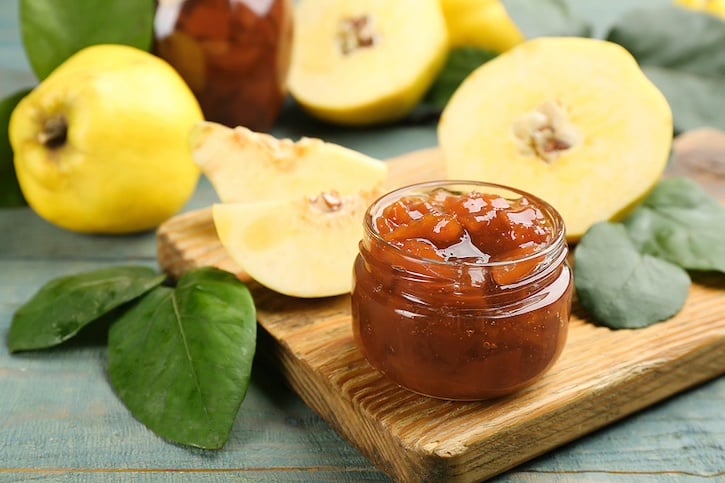Quince is a fall fruit that has an enticing floral scent. Here’s a brief guide to quince, a fruit that has some resemblance to pears and apples, yet defies definition, with tips on how to buy and prep. Plus, ideas on use it and links to recipes.

Quince have yellow-colored peels, with a somewhat uneven bumpy surface. Some have fuzzy skin; others are smooth; skin color varies from yellow to chartreuse. Inside, the flesh is whitish-yellow with a texture similar to hard, underripe pears.
Uncooked, they taste dry and astringent (that is to say, somewhat tart). Eating them raw is not harmful, but isn’t the best way to use them.
Cooked, they become soft and flavorful, most varieties turning an appealing orange-red color. The fragrance is an alluring blend of pear and pineapple.
The quince fruit grows on a low-growing ornamental tree that belongs to the rose family. It originated in the Mediterranean and Asia thousands of years ago. Here’s more than you’ll ever need to know about quince.
The best quince fruit is grown in warm areas, but it can thrive in semi-tropical and temperate climates as well. Quince trees are easy to grow and maintain, and will yield fruit within a few years.
This information is excerpted and adapted from Melissa’s Great Book of Produce: Everything You Need to Know About Fresh Fruits and Vegetables by Cathy Thomas ©2006, reprinted by permission of Melissa’s Produce.
Buying and storage
Look for firm fruit without spots or discoloration. Often, shrublike quince trees are part of natural landscaping, and the edible fruits they yield are a bonus.
Store at room temperature for up to 1 week; left out, they will fill the room with “quince perfume.” Or for longer storage, place in refrigerator for up to 3 weeks. Cooked quince wedges can be frozen up to 3 months, packed into tightly lidded containers.
Look for quince in fall and early winter farmers markets and specialty groceries. Or, order online from produce distributors.
Seasonality of quince
- Domestic: September—December
- Global: May—July
How to prep quince
Wash in cold water; if fuzzy, rub with clean towel. Cut into quarters; core and peel. Cook or use as instructed in recipes, usually further sliced or coarsely chopped. Quince isn’t easy to cut and peel as an apple. Some patience is required!
Nutrition info
Quince is a good source of vitamin C. It also contains a significant amount of copper and iron. Here’s its complete nutritional profile.
General uses
Quince can be baked, sautéed, braised, or poached. It’s often used to make jelly, jam, and fruit butter. If used slightly underripe (green-tinged), quince higher in pectin and are superior for jam or jelly making. Quince can be use braised (or baked) like apples in sweet or savory dishes.
Some classic recipes for quince include Spanish membrillo, French contignac, and Italian mostarda Montovana, all confections that require a lot of sweetening.

Serving suggestions
Quince ‘n’ cream: Poach quince wedges (peeled and cored) in brandy until tender. Spoon over dairy-free ice cream or frozen yogurt.
Quince and apple or pears in pastries: Combine quince slices (peeled and cored) with pear or apple slices in pies, cobblers, or crisps.
Slow cooker baked quince: Place whole, cored quince in slow cooker (if corer isn’t sturdy enough to remove core, cut quince in half and core). Fill quince cavities with raisins mixed with natural granulated sugar, cinnamon, and, if desired, chopped walnuts. Add 3/4 cup water to bottom of pot. Cover and cook on low setting overnight or 8 hours. Serve warm, if desired, with vegan creamer, whipped topping, or yogurt.
Chunky quince sauce: Cover quince slices (peeled and cored) apple juice in saucepan; cover and simmer until tender. Drain and pulse in food processor until “saucy.” Add sugar and ground cinnamon to taste.

Ginger Quince Butter
This delectable spread can be slathered over pancakes, biscuits, waffles, or toast. This makes about 2 cups.
- 3 medium or 4 small quince, peeled, cored, and sliced
- 1 1/2 cups water
- 1 cup apple juice
- 3 tablespoons lemon juice
- 1/2 cup natural granulated sugar
- 1/2 cup maple syrup or agave
- 1 tablespoon minced lemon zest
- 1 tablespoon minced fresh or squeeze-bottle ginger
- 1 teaspoon ground cinnamon
- 1/2 teaspoon ground nutmeg
1 Place quince, water, and juices in medium saucepan. Bring to boil on high heat. Reduce heat to low and simmer about 30 minutes or until quince is very tender.
2 Stir in remaining ingredients. Increase heat to medium-high and bring to gentle boil, stirring constantly, for 5 minutes. Puree in blender or food processor, or leave a little chunky.
3 Can be refrigerated up to 1 week, or frozen in small containers up to 3 months.
Plant-based recipes for using quince
- Quince Jam
- Quince Jelly
- Quince Butter
- Quince and Currant Chutney
- Quince and Cranberry Chutney
- Spiced Quince and Apple Sauce
- Quince-Apple Crisp (swap in vegan butter)
- Vegan Quince Tartlets
- Roasted Pears and Quinces with Tangerine Zest
- Quince-Cinnamon Compote
See more Good Food Guides on this site.
You might also like …

12 Unusual and Exotic Fruits You Need to Try at Least Once

Melissa’s Great Book of Produce is available wherever books are sold


Leave a Reply